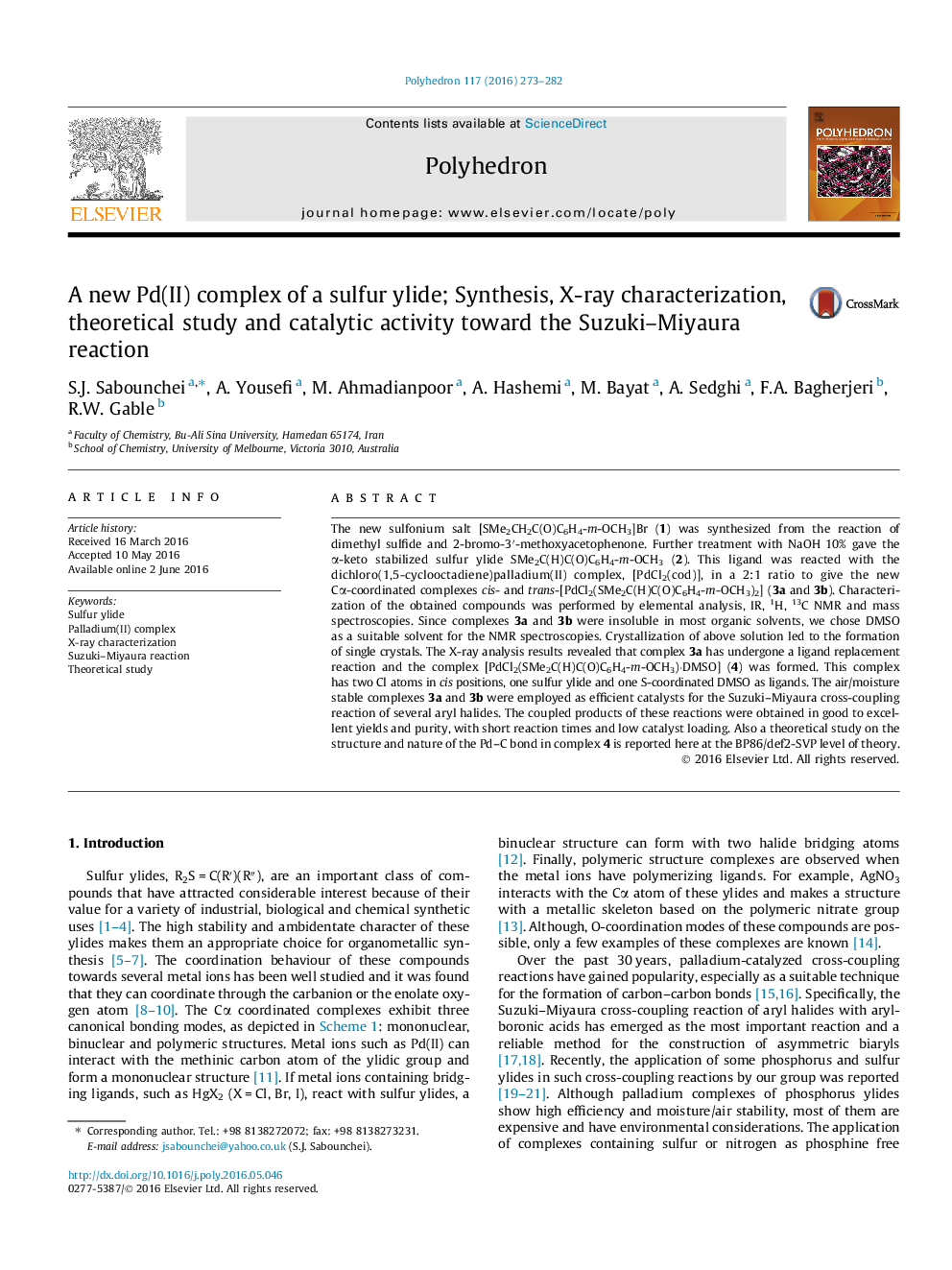| Article ID | Journal | Published Year | Pages | File Type |
|---|---|---|---|---|
| 1336207 | Polyhedron | 2016 | 10 Pages |
The new sulfonium salt [SMe2CH2C(O)C6H4-m-OCH3]Br (1) was synthesized from the reaction of dimethyl sulfide and 2-bromo-3′-methoxyacetophenone. Further treatment with NaOH 10% gave the α-keto stabilized sulfur ylide SMe2C(H)C(O)C6H4-m-OCH3 (2). This ligand was reacted with the dichloro(1,5-cyclooctadiene)palladium(II) complex, [PdCl2(cod)], in a 2:1 ratio to give the new Cα-coordinated complexes cis- and trans-[PdCl2(SMe2C(H)C(O)C6H4-m-OCH3)2] (3a and 3b). Characterization of the obtained compounds was performed by elemental analysis, IR, 1H, 13C NMR and mass spectroscopies. Since complexes 3a and 3b were insoluble in most organic solvents, we chose DMSO as a suitable solvent for the NMR spectroscopies. Crystallization of above solution led to the formation of single crystals. The X-ray analysis results revealed that complex 3a has undergone a ligand replacement reaction and the complex [PdCl2(SMe2C(H)C(O)C6H4-m-OCH3)·DMSO] (4) was formed. This complex has two Cl atoms in cis positions, one sulfur ylide and one S-coordinated DMSO as ligands. The air/moisture stable complexes 3a and 3b were employed as efficient catalysts for the Suzuki–Miyaura cross-coupling reaction of several aryl halides. The coupled products of these reactions were obtained in good to excellent yields and purity, with short reaction times and low catalyst loading. Also a theoretical study on the structure and nature of the Pd–C bond in complex 4 is reported here at the BP86/def2-SVP level of theory.
Graphical abstractThe new sulfonium salt [SMe2CH2C(O)C6H4-m-OCH3]Br (1) was synthesized from the reaction of dimethyl sulfide and 2-bromo-3′-methoxyacetophenone. Further treatment with NaOH 10% gave the α-keto stabilized sulfur ylide SMe2C(H)C(O)C6H4-m-OCH3 (2). This ligand was reacted with the dichloro(1,5-cyclooctadiene)palladium(II) complex, [PdCl2(cod)], in a 2:1 ratio to give the new Cα-coordinated complexes cis- and trans-[PdCl2(SMe2C(H)C(O)C6H4-m-OCH3)2] (3a and 3b). The X-ray analysis results revealed that complex 3a has undergone a ligand replacement reaction in DMSO solution and the complex [PdCl2(SMe2C(H)C(O)C6H4-m-OCH3)·DMSO] (4) was formed. The air/moisture stable complexes 3a and 3b were employed as efficient catalysts for the Suzuki–Miyaura cross-coupling reaction of several aryl halides. Also a theoretical study on the structure and nature of the Pd–C bond in complex 4 is reported here at the BP86/def2-SVP level of theory.Figure optionsDownload full-size imageDownload as PowerPoint slide
